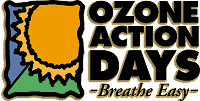|
 |
|
Know the Facts |
| Ozone is becoming more of a topic of
conversation...especially during Summer. Learn more about ozone
below. |
|
|
 |
Ozone
Advisory/Alert Status |
 |
|
| There is currently no Ozone Action Advisory/Alert in effect. To check out the last
Air Quality Index Statement issued, click here. |
|
 |
Air
Quality/Keeping Ozone Levels Down |
 |

|
| The months of May through September are the most common months for significant ground-level ozone
concentrations in Arkansas. When the Department of Environmental Quality (ADEQ) expects the 8-hour average of ozone concentrations to reach
or exceed 85 parts per billion, an Ozone Action Advisory will be
declared. When ADEQ expects the 8-hour average of ozone concentrations to reach or exceed 105 parts per billion,
an Ozone Action Alert will be declared. Note: Arkansas counties included
in the program are Faulkner, Lonoke, Pulaski and Saline.
|
|

|
| There are several air quality categories to note. If the forecast calls for
an orange category (i.e. "Unhealthy for Sensitive Groups"), an Ozone
Action Advisory is posted. If the forecast calls for a red category (i.e. "Unhealthy"),
an Ozone Action Alert is posted. The categories are as follows: |
|
 |
No health impacts are expected. |
|
|
 |
Unusually sensitive people should consider limiting prolonged
outdoor exertion. |
| |
 |
Active children and adults, and
people with respiratory disease such as asthma should limit
prolonged outdoor exertion. |
| |
 |
Active children and adults, and
people with respiratory disease such as asthma should avoid
prolonged outdoor exertion. Everyone else should limit
prolonged outdoor exertion, especially children. |
| |
 |
Active children and adults, and
people with respiratory disease such as asthma should avoid
all outdoor exertion. Everyone else should limit outdoor
exertion, especially children. |
|
| |

|
| Click the links below to learn more about ozone
and to check out the latest ozone forecast. To help keep ozone
levels down, read
the Do and Don't columns below the links.
|
|
|
To keep
ozone levels down:
Do:
 |
limit your driving. Share a ride, carpool, walk or ride the bus. |
 |
combine as many errands as possible. |
 |
keep your car well tuned, avoid jackrabbit starts and excessive
idling. |
 |
stay indoors as much as possible. |
|
 |
| logo used by permission (on file) |
|
|
|
Ozone Action Days are a program of Metroplan and the Central
Arkansas Clean Cities Coalition, in cooperation with the
Department of Health, Department of Environmental Quality (ADEQ),
and the State Highway and Transportation Department. |
|
|
Ozone
is formed in the lower atmosphere on hot windless days when volatile organic compounds
(VOCs), such as gasoline and paint fumes, interact in sunlight with nitrous oxide (NOx)
emissions from motor vehicles, gasoline powered lawn mowers, and various other combustion
activities.
When high ozone concentrations are forecast, Ozone Action Days are declared by the
Arkansas Department of Environmental Quality (ADEQ). |
|
|
To
keep ozone levels down:
Don't:
 |
do lawn and garden chores that require gas
powered equipment. |
 |
use oil-based paints and solvents. |
 |
use products that release fumes or evaporate
easily. |
 |
refuel. If you must, do it after dark and
don't fill the tank completely. |
 |
exercise outdoors. |
|
|


